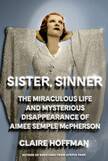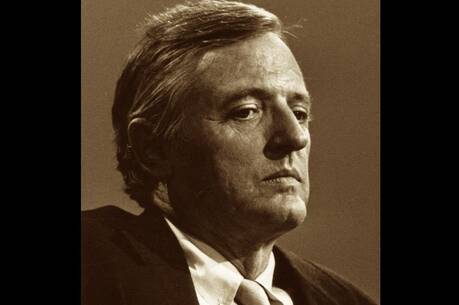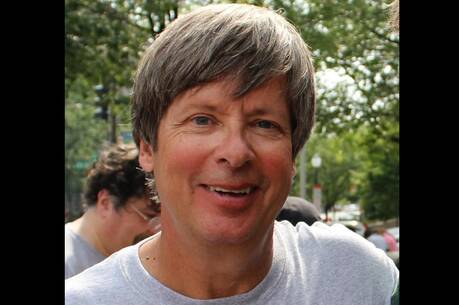Review: Aimee Semple McPherson, America’s first media evangelist
The title of Claire Hoffman’s new book, Sister, Sinner: The Miraculous Life and Mysterious Disappearance of Aimee Semple McPherson, promises miracles and scandals. Hoffman delivers with a fast-paced page turner for the reader. Attentive to descriptive details and candid about the contradictions in the life of her subject, Hoffman breathlessly follows the life of Aimee Semple McPherson (1890-1944). This biography brings into print another review of the achievements and personal failures of this major pioneer of media evangelism.
Contemporary readers may not recognize McPherson’s name, but many are acquainted with modern media evangelism. McPherson was an early figure in religious broadcasting with her own radio station in Los Angeles, as one of the first women to obtain a license to broadcast in the 1920s. A mesmerizing speaker, she was a prodigious author of sermons, books, articles, pamphlets, hymns and plays to spread the message of Pentecostalism. She was ever alert to opportunities for publicity, and her church services drew crowds by the thousands, week after week, for many years. McPherson relentlessly pursued public attention throughout her life, and the publication of another biography would probably have pleased her.
McPherson was the daughter of a small-town Canadian farmer aged 50 and his 15-year-old bride who was active in the Salvation Army. Drawn to her mother’s church activities, McPherson married the evangelist Robert Semple at an early age in 1910, and the two set off for China as missionaries. After his death and the birth of her daughter, Roberta, she returned to Canada and soon continued her calling as a messenger of Pentecostal faith. She quickly remarried, to Howard McPherson, and she and her new husband hit the revival circuit along the East Coast, where she preached in tent meetings. After the birth of a son, she separated from her husband and set off across the country, driving her “Gospel Car” to Los Angeles in 1918 with her mother and her two children.
McPherson’s arrival in Los Angeles coincided with a period of dramatic growth in the city’s population. Residents increased from 576,000 in 1920 to 1.2 million in 1930. Newcomers to the city thronged to McPherson’s preaching, and within four years, she had built a 4,500-seat church, Angelus Temple. Followers of her Foursquare Gospel church spread throughout Southern California and radiated across the continent. Soon she was sending missionaries overseas, engaged in publishing and then broadcasting by radio. It was at the height of her popularity that she was reputedly kidnapped in 1926.
Hoffman explores this episode in detail, a moment when everyone’s beloved “sister” appeared as a sorry “sinner.” Emerging from the Sonoran Desert, McPherson walked into Douglas, Ariz., unscratched and without sunburn or thirst. She told a tale that enemies of her church had captured her while at the beach in Venice, Calif., and transported her across the border for nefarious purposes. While her return to Los Angeles brought her a triumphant welcome by thousands, investigators were increasingly dubious of her account.
Her subsequent trials for obstructing justice coincided with increasing evidence of a love nest up the California coast in Carmel. Revelations by witnesses and reporters identified Kenneth G. Ormiston, radio man of her church’s station, as her paramour. McPherson challenged all accusations with dramatic accounts of the devil’s intent to stop her ministry by any means possible.
These developments brought her national publicity, as well as increasing ridicule. Undeterred, McPherson continued her ministry of preaching the true Gospel and attacking skeptics in government and the district attorney’s office as well as civic and religious leaders.
McPherson further complicated her life when she rejected even those closest to her. She alienated both her mother and her daughter, Roberta, by her changed lifestyle, stylish clothes, international trips and financial extravagances. Hoffman interprets this familial alienation as the effect of fame and McPherson’s passionate pursuit of attention and publicity. Greater psychological analysis would have enhanced this biography of a farmer’s daughter transported into a glamorous life worthy of the stars in nearby Hollywood.
Hoffman correctly assesses McPherson as an astute entrepreneur. Starting out with religious tracts, McPherson expanded her print outreach into a magazine that reached thousands across the nation. When she introduced theater into her church services, she attracted churchgoers who otherwise avoided vaudeville and the movies. She hired costumers, set designers and lighting technicians from Hollywood and recruited musicians and choirs to enhance religious services. In one of her more notable dramatizations of her preaching, she donned a police uniform, rode a motorcycle into the sanctuary and exhorted the congregation to “Halt!” on their way to perdition.
A spellbinding speaker, McPherson was both an insightful religious leader and a poor manager of money. It was her mother, “Ma” Kennedy, who counted collections, paid employees and handled finances. The increasingly tense mother-daughter dynamic and eventual animosity is another topic that warranted further attention in this biography. In her efforts to provide greater credit to McPherson as a successful leader in a male-dominated world, Hoffman slights her subject’s evolving erratic behavior. McPherson’s flexible approach to truth-telling repeatedly masked her deviation from Christian values and the behavior she preached to her followers. While seeking attention, McPherson provided critics with ample material to conclude that she hypocritically exploited her followers for her own gain.
Much to her credit, Hoffman read extensively in the enormous coverage that her subject garnered. McPherson’s church theatrics, the reputed kidnapping and her defense, spats with her mother, her third marriage and divorce, and numerous lawsuits provided newspaper coverage for many years. Nor did journalists ignore McPherson’s death from an accidental overdose of sleeping pills in 1944. Assessing this vast array of articles, along with McPherson’s two autobiographies, four previous biographies and the hitherto unavailable material in the Foursquare Gospel Church archives must have been a herculean task.
Given the mountain of documentation, along with the brilliance of “Sister Aimee” herself, Hoffman’s enthusiasm for her subject is understandable. The book includes numerous instances of the author’s intent to emphasize the accomplishments of McPherson. Fair enough. Such an overall interpretation is understandable but not entirely convincing. I began to wonder if the heights McPherson ascended were that much higher than those scaled by other preachers. Were the goals she achieved more significant than the achievements of other people in similar situations, such as in radio broadcasting?
One fact remains, despite possible exaggeration in Hoffman’s interpretation: Aimee Semple McPherson pioneered media evangelism. As a speaker, she was “spellbinding, hypnotic, powerful.” She preached an appealing image of Jesus as the forgiving bridegroom who beckoned born-again believers (she named her magazine The Bridal Call). She portrayed herself as a larger-than-life character called to spread God’s message, yet she acknowledged her faults so that her followers could easily identify with her. She was undaunted in taking risks, such as investing early in radio and pioneering in mass media to spread the message of Christ.
Not easily categorized, McPherson was also deeply committed to aiding the poor while she excelled as a prolific fundraiser. In Depression-era Los Angeles, her church developed one of the city’s largest service agencies that fed hungry people (2,100 meals daily), offered medical and dental care, and operated a nursery school, a laundry and an employment office. During World War II, McPherson proved to be a champion at selling war bonds while promoting a vigorous patriotism. And she did all this as a woman who was not afraid to lead, to speak out and to share her fundamentalist faith.
Claire Hoffman has provided a new generation with an introduction to the multi-faceted career of Aimee Semple McPherson. She has done so in a stirring narrative that shares the highs and lows of her complex subject’s life. While other authors have placed McPherson in a larger and more sophisticated historical context, Hoffman’s fast-paced account allows contemporary readers to recognize the entrepreneurial spirit of this pioneering female leader in fundamentalism and religious media.
This article also appeared in print, under the headline “Spellbinding, Hypnotic, Powerful,” in the July/August 2025, issue.











